Brandenburg
![]()
The title of this article is ambiguous. For other meanings, see Brandenburg (disambiguation).
Brandenburg [![]()
![]() ˈbʁandn̩ˌbʊʁk] (Lower Sorbian Bramborska; Low German Brannenborg; official: Land Brandenburg) is a state in the northeast of the Federal Republic of Germany. The state capital and most populous city is Potsdam, other important centres are Cottbus, Brandenburg an der Havel and Frankfurt (Oder).
ˈbʁandn̩ˌbʊʁk] (Lower Sorbian Bramborska; Low German Brannenborg; official: Land Brandenburg) is a state in the northeast of the Federal Republic of Germany. The state capital and most populous city is Potsdam, other important centres are Cottbus, Brandenburg an der Havel and Frankfurt (Oder).
Brandenburg surrounds the German capital Berlin at its centre and together with it forms the European metropolitan region of Berlin/Brandenburg, which is home to around 6 million inhabitants. More than a third of Brandenburg's area is taken up by nature parks, forests, lakes and water areas.
The founding year of the Mark Brandenburg is 1157, when the Ascanian Albrecht the Bear reconquered Brandenburg and made it part of the Holy Roman Empire. From 1415 to 1918 the region was under the rule of the Hohenzollerns. From 1701 to 1946, the Mark developed into the heartland of Prussia. The province of Brandenburg, created in 1815, existed until 1947, at which time Brandenburg reached its greatest territorial extent. After 1945, a state of Brandenburg was founded for the first time from its part east of the Elbe and west of the Oder and Neisse, which was later divided into various GDR districts. The part east of it came to the People's Republic of Poland and forms today for the most part the voivodeship Lebus, while a smaller part belongs to the voivodeship West Pomerania. Brandenburg then re-established itself as a state of the Federal Republic of Germany in 1990.
The main economic sectors in Brandenburg include agriculture, the energy industry, aerospace industries, tourism and the film industry.
Geography
The state of Brandenburg is located in the northeast of the Federal Republic of Germany. It borders Saxony to the south, Saxony-Anhalt to the west, Lower Saxony to the northwest, Mecklenburg-Western Pomerania to the north, and the Republic of Poland to the east. Brandenburg has five exclaves, which lie within the borders of Saxony-Anhalt and belong to the municipalities of Buckautal and Ziesar. Brandenburg is the fifth largest state in Germany by area, with a total area of 29,654 km², and is also the largest of the new states, with a maximum diagonal extent of 291 km, a north-south extent of 244 km, and an east-west extent of 234 km. The core area of Brandenburg is also referred to by the historical name Mark Brandenburg.
In terms of economic geography, the states of Berlin and Brandenburg together form the European metropolitan region of Berlin/Brandenburg. Around six million inhabitants live in the conurbation known as the Berlin-Brandenburg capital region. The Berlin agglomeration, with 4.4 million inhabitants, whose narrower area around Berlin is known as the "Speckgürtel", includes Berlin and parts of Brandenburg. This corresponds to the typical orientation of Brandenburg's infrastructure, such as motorways and main railway lines, towards the federal capital Berlin, which is located in the state in the form of an island.
Outside of the larger cities such as Brandenburg an der Havel in the west, Frankfurt (Oder) in the east and Cottbus, the city with the largest population after Potsdam, in the south, the state is relatively sparsely populated. The south of the state is made up of Lower Lusatia, small parts of Upper Lusatia and the Elbe-Elster region. To the west of Brandenburg belong the Havelland, south of Berlin the Teltow and northeast the Barnim. On the borders lie in the north the Oberhavel (with the Fürstenberger Werder, which historically belonged to Mecklenburg until 1950), in the northwest the Prignitz, in the northeast the Uckermark, in the east the Oderbruch and in the southwest the Fläming.
Geology and soils
→ Main article: Geology and landscape development in Brandenburg
The state of Brandenburg is located in the North German Lowlands and was decisively shaped on the earth's surface by the repeated advances of the Scandinavian inland ice during the Ice Age. Therefore, almost exclusively cold and warm period deposits are present. The most common deposits are boulder clay and meltwater sands. Typical for the surface formation are the elements of the glacial series. One of their landscape forms is the glacial valley. These show a worldwide unique accumulation in this country: Netze-Randow, Thorn-Eberswalde, Warsaw-Berlin, Glogau-Baruth and Wroclaw-Bremen glacial valleys.
Due to the diversity of the glacial deposits in Brandenburg, the resulting soil communities are very diverse. Their yield ranges from extremely nutrient-poor and infertile to very fertile. Nevertheless, the nutrient-poor sandy soils, which give the state its characteristic character, predominate in terms of area, especially in central and southern Brandenburg.
Brandenburg is considered a supplier of raw materials, especially in the south. Large lignite deposits are located along the Lausitzer Grenzwall, and deep copper deposits have been found in the southeast around Spremberg. Oil has been found in isolated cases in the area.
Landscapes
The main large-scale landscapes of Brandenburg are, from north to south, the Baltic or Northern Land Ridge, the zone of plates and glacial valleys, and the Southern Land Ridge.
Heights of over 100 m are reached on both land ridges. In Brandenburg, the Fläming and its eastern continuation, the Lausitzer Grenzwall with the Muskauer Faltenbogen are assigned to the Southern Land Ridge, which reaches from the Harburg Mountains to Poland (Katzengebirge). It is on average higher than the Baltic Land Ridge. The latter stretches from Jutland to the Baltic. It includes the Mecklenburg Lake District, which extends into Brandenburg. The rivers Havel, Rhin and Dosse have their source in this lake district. In the southeast with the Lausitzer Urstromtal (part of the Breslau-Bremer Urstromtal) and northeast with low-lying parts of the Uckermark, Brandenburg extends beyond the aforementioned mountain ranges.
Between the land ridges lies the area of the central Brandenburg plates and glacial valleys. Extensive lowlands such as the Rhinluch, the Havelländisches Luch and the chain of lakes of the middle Havel delimit the island-like rising plates such as Barnim, Nauener Platte and the Ländchen from each other. The level of the Urstrom valleys and the associated side valleys shows a slight gradient from southeast to northwest. It ranges from about 60 m at the Neisse to below 20 m at the mouth of the Havel. The average height of the slabs decreases from east to west from more than 100 m at the Oder to 40 m to 50 m in the west. The Oder valley is particularly deep in the northeast almost at sea level.
In terms of landscape, the difference between the old moraine and the young moraine country is striking. While there are almost no natural lakes in the south and in the Prignitz, the young glaciated area is rich in lakes. There are regional differences. Many high-lying ground moraine areas, such as the Barnim or the Land Lebus, are poor in lakes. On the other hand, areas such as parts of the western Uckermark, where large areas of dead ice blocks were buried and preserved, are rich in lakes.
|
|
|
|
|
See also: List of landscapes in Brandenburg
Climate
The state of Brandenburg is located in the transitional area between the oceanic climate in Western Europe and the continental climate in the East. Due to the relatively small differences in altitude, the climatic differences within the state are rather small, but can be felt in certain weather conditions.
The average annual temperature is around 9 °C. The coldest month is January with an average of -1 °C. The warmest month is July with an average temperature of 18 °C. With the air temperature, a slight increase in continentality is already noticeable from Prignitz, located in the northwest, to Niederlausitz, located in the southeast. Especially in the winter months, with low wind radiation weather conditions, Lusatia is usually significantly colder than Prignitz.
With an average annual precipitation sum of less than 600 mm, Brandenburg is one of the driest federal states, perhaps the one with the least precipitation. Mostly the average annual precipitation is around 550 mm. Only the Prignitz, located in the northwest, and some high areas such as the Hohe Fläming and the Hohe Barnim reach or exceed the 600 mm mark per year. East of the highlands, a low rain shadow is noticeable, so the low-lying Oderbruch is one of the driest regions in Germany with less than 500 mm annual precipitation.
While winter and spring are comparatively dry, precipitation throughout the state falls mainly in the summer months. Nevertheless, pronounced dry phases can also occur during the warm season, during which the risk of forest fires in Brandenburg rises sharply. In 2018, Brandenburg's forests burned 512 times (an average of around 300 forest fires per year), including eleven major fires. The sun shines for an average of about 1600 hours a year.
In order to stabilise the forest for the demands of climate change (including heavy rainfall and droughts), the state of Brandenburg spends 8.5 million euros annually (as of 2018) on a forest conversion programme in order to achieve, among other things, an increased presence of different tree species in several age classes.
Effects of climate change
From 1881 to 2018, the temperature in Brandenburg increased by 1.3 degrees Celsius compared to the pre-industrial value. This value could rise to 3.8 degrees by the end of the century if the current development path is maintained. According to assumptions, Brandenburg will be increasingly affected by extreme weather events, including longer periods of drought and locally occurring heavy precipitation events. In addition, the phenological seasons will shift; winter will become shorter, spring will begin earlier and autumn will become longer. Overall, a three-week longer vegetation period can be assumed on average in Brandenburg, which will have an impact on fruit and wine growing, agriculture, forests, as well as on biotic communities and species. Due to global warming, the sea level is expected to rise by 80 to 100 cm by the turn of the century; thus, the salt water limit is located in the Lower Oder Valley.
Waters
Brandenburg is considered to be the federal state with the most water bodies in Germany. There are over 3000 naturally formed lakes, in addition to numerous man-made ponds, quarry lakes and similar bodies of water. Furthermore, there are more than 33,000 km of running waters, most of which are man-made drainage ditches and other canals. On the other hand, due to the lack of precipitation in Brandenburg, the groundwater is renewed only very slowly. The residence time of the water in the water bodies is therefore quite long.
Rivers
Larger rivers touch Brandenburg only at its borders. The Elbe (total length 1091 km) runs for a few kilometers in the extreme southwest and northwest of Brandenburg, where it marks the state border almost without exception. Only the 0.5 km² area around the ferry landing stage at the mouth of the river Dahle, including a section of the federal road 182, which belongs to Mühlberg, represents the only area of Brandenburg on the left bank of the Elbe. The Oder (total length 866 km) forms together with the Neiße as its tributary the entire eastern border of Brandenburg. Only the outermost northeastern border kilometres are excluded.
Brandenburg's most important inland rivers are the 334 km long Havel and the 400 km long Spree as its largest tributary. The Spree has more water at its confluence than the Upper Havel, so that the Spree and the Lower Havel form a 560 km long river course running mainly in Brandenburg (350 km of which are navigable). All other watercourses in Brandenburg are small rivers and streams of regional importance. In northern Brandenburg, the Stepenitz, the Dosse, the Rhin, the Ucker and the Finow are worth mentioning. In the central part, the Plane, the Nieplitz, the Panke, the (Jüterboger) Nuthe, the Notte and the Dahme have some importance. The largest river in the south of Brandenburg is the Schwarze Elster. After that, rivers like the Kleine Elster, the Oelse or the Schlaube have to be mentioned.
See also: List of rivers and canals in Brandenburg
Lakes
Due to its ice-age formation history, Brandenburg is extremely rich in naturally formed lakes. There are more than 800 bodies of water with an area of more than one hectare. The largest natural lake in Brandenburg is the Schwielochsee with an area of 13.3 km². It is followed by the Scharmützelsee (12 km²), the Unteruckersee (10.4 km²), the Parsteiner See (10 km²), the Ruppiner See (8.25 km²), the Schwielowsee (7.9 km²), the Werbellinsee (7.8 km²) and the Grimnitzsee (7.8 km²). With a depth of almost 70 m, the deepest lake in the state and also the one with the best water quality is the Großer Stechlinsee.
In addition to the numerous natural lake areas in Brandenburg, there is also a man-made lake area: the Lusatian Lakeland is the result of the flooding of open-cast mining pits that are no longer in use. At 13 km², Lake Senftenberg is currently the largest body of water in it. In 2025 it will be Europe's largest artificial water landscape and Germany's fourth largest lake district. Lake Sedlitz (13.3 km²) will grow to become the largest lake by then, and together with Lake Schwieloch it will be the largest lake in Brandenburg. The Spremberg dam, with 6.7 km², forms the largest reservoir in Brandenburg.
See also: List of lakes in Brandenburg
flora and fauna
In 2011, the primeval beech forests were included in the World Heritage List. Among others, the beech forest in Grumsiner Forst in the Schorfheide-Chorin Biosphere Reserve has been declared part of the World Natural Heritage. Here, there are distinctive flutter grass beech forests, which are considered to be the remnants of the large-scale beech stands that once existed in Central Europe.
The Lower Oder Valley National Park is home to the kingfisher and the sedge warbler, which is one of the most endangered songbirds in Europe. Larger populations of this songbird species can otherwise only be found in the marsh and floodplain landscapes of Eastern Europe further to the east. White storks breed on the roofs of the surrounding villages. Also to be found, albeit very hidden, are the very rare black storks, of which there are currently 3 to 5 breeding pairs. Rare bird species such as the lesser spotted eagle have also found a refuge there.
The meadows, which are flooded in winter, offer resting opportunities for numerous migratory birds. Among the birds that can be observed here is, for example, the Whooper Swan. The breeding birds of this national park include such rare meadow breeders as the corncrake, the ruff and the black-tailed godwit, and the oriole nests in the floodplain forests and the deciduous forests of the Oder slopes. The largest breeding colony of the Black Tern is also located in the national park.
Wild boars, otters, beavers, wolves, raccoons, roe deer, red deer and white-tailed eagles have settled in Brandenburg as permanent species.
Nature Parks
A total of 15 so-called large protected areas have been designated in Brandenburg. They cover about one third of the state's area. These include the Lower Oder Valley National Park (106 km²) and the three areas designated as UNESCO biosphere reserves: the Elbe-Brandenburg River Landscape Biosphere Reserve (533 km²), the Schorfheide-Chorin Biosphere Reserve (1291 km²) and the Spreewald Biosphere Reserve (474 km²). In addition, there are eleven nature parks: Barnim Nature Park (750 km²), Dahme-Heideseen Nature Park (594 km²), Hoher Fläming Nature Park (827 km²), Märkische Schweiz Nature Park (204 km²), Niederlausitzer Heidelandschaft Nature Park (490 km²), Niederlausitzer Landrücken Nature Park (580 km²), Nuthe-Nieplitz Nature Park (623 km²), Schlaubetal Nature Park (225 km²), Uckermärkische Seen Nature Park (895 km²), Westhavelland Nature Park (1315 km²), Stechlin-Ruppiner Land Nature Park (1080 km²).
· 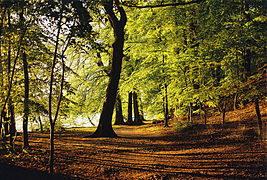
Forest area at the Werbellinsee
· 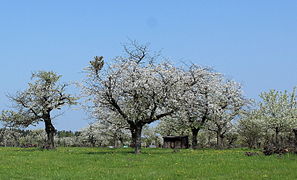
Orchard meadow in the Niederlausitzer Heidelandschaft Nature Park
· 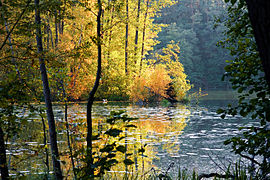
Small ham lake in the nature park Schlaubetal
· 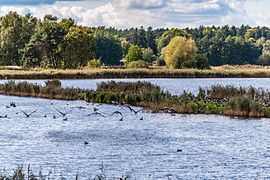
Wild geese at the Blumberger fish ponds in the biosphere reserve Schorfheide-Chorin
· 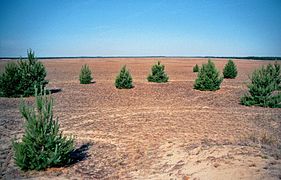
Lieberos Desert

Grass Snake

Otter
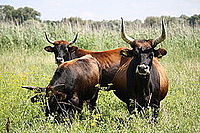
Heck Cattle
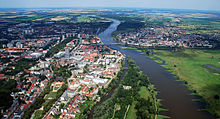
The Oder near Frankfurt (Oder)
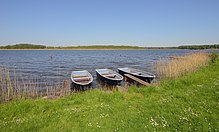
Lake Ruppin

Climate diagram of Potsdam
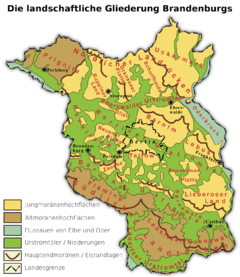
The landscapes of Brandenburg

Angermünde in the Uckermark in the northeast of the state of Brandenburg

Limestone quarry Rüdersdorf in winter
History
→ Main article: History of Brandenburg
The beginnings of Brandenburg
→ Main article: Mark Brandenburg and History of Lower Lusatia
The Germanic peoples who settled in the area of today's Brandenburg largely left the region during the migration of peoples in the 4th to 6th centuries. In the 7th/8th century Slavs immigrated in several waves. Under Henry I, an East Frankish army conquered Brandenburg, the centre of the land of the Hevellers, in the winter of 928/929. These were now subject to tribute. Otto I intensified the previously loose integration, established the Saxon Ostmark mentioned in 937. A few years after his coronation as Emperor of the (Holy) Roman Empire in 962, the bishoprics of Brandenburg, Havelberg and Meissen were created.
In 965 the Ostmark was divided up. The south, including the Mark Lausitz (later Niederlausitz), remained under German rule. In the Northern Mark, however, it ended with the Slavic uprising of 983. Despite repeated attempts of conquest, German settlement in the East and Christianization stopped here for more than 150 years. (In detail, the development looked more differentiated.) From the 1st third of the 12th century, Pomerania, Poland, Silesia, Mark Meissen, Erzmagdeburg, German royal and Saxon noble houses struggled for supremacy here. The Polish claims manifested themselves, for example, in the founding of the bishopric of Lebus in 1124. Ultimately, a noble family was to assert itself, which derived its name from the castle of Aschersleben.
Albrecht the Bear of the House of Ascania established a close relationship with Pribislav. The Hevell prince died childless in 1150 and his land was inherited by Albrecht I, who took over Brandenburg relatively peacefully. Jaxa, possibly the prince of the Sprevans under Polish suzerainty, found himself disinherited as a relative of Pribislaw. In the spring of 1157, the castle gate was opened to him by means of bribery, and he moved in with a Polish army in a coup d'état. The reconquest succeeded Albrecht I, supported by other Saxon nobles as well as the Magdeburg archbishop Wichmann, on June 11, 1157. This date is generally considered the birthday of the Mark Brandenburg.
In the gradual expansion of their sovereignty and territory, the Ascanians were largely able to displace or integrate their rivals. Only the dominion of Ruppin and the three high monasteries of Brandenburg, Havelberg, and Lebus more or less maintained their immanent positions. The Slavs were resettled in isolated cases, such as the foundation of the Chorin monastery. As a rule, they participated equally in the expansion of the country. Towards the end of the 12th century, the importance of the Margraves of Brandenburg in imperial politics grew with the electoral dignity. These ruled from 1302/1304 also in the Mark Lausitz. In 1320 the Brandenburg line of the Ascanians died out.
The house power politics of the Wittelsbach and Luxembourg dynasties continued to link the history of the two Marches. From the Margraviate-Brandenburg point of view, the times of the Wittelsbach (1323-1373) and Luxembourg (1373-1415) were a phase of rather weak sovereigns. Only the short stabilization under Charles IV stood out. Under his reign, first the Mark of Lusatia (1370), then the Mark of Brandenburg (1374) were incorporated into the lands of the Bohemian Crown.
From 1411, finally from 1415, the Mark Brandenburg was subject to the dynasty of the Hohenzollern. They successfully pacified the land and restored the central power. The Mark Brandenburg, destroyed and impoverished by the Thirty Years' War, was gradually rebuilt since 1640 by Frederick William. This process was briefly interrupted by the invasion of the Swedes in 1674/1675, but the Great Elector and General Georg von Derfflinger won decisive victories in the battles of Rathenow, Nauen and especially Fehrbellin.
Brandenburg took a continuous upswing since 1648, also supported by a strong Brandenburg army. With its southern neighbor, the Electorate of Saxony, the state maintained close and cooperative relations in the 17th century.
Prussia (1701-1947)
→ Main article: Kingdom of Prussia
From 1701 to 1946, the Mark Brandenburg shared the political history of the Prussian state as a whole. In 1701, the Elector Frederick III of Brandenburg crowned himself King of Prussia. The elevation of the Elector's rank initially only changed the designation of state institutions such as the army, ambassadors and authorities from "Elector Brandenburg" to "Royal Prussia". The importance of the central province of Mark Brandenburg with its residential landscape around Berlin and Potsdam grew all the more as Brandenburg-Prussia developed into a central, absolutist state with ambitions for Germany and Europe. Under King Frederick I's rule from 1688 to 1713, the population of the Mark increased by about a third to more than 730,000 inhabitants in 1713. The number of towns rose to 120, including the cities of Brandenburg an der Havel and Frankfurt an der Oder, which reached a population of 10,000.
During the Seven Years' War from 1756 to 1763, the Mark once again became a theater of war. Austrian and Russian troops repeatedly advanced into the Mark and temporarily occupied Berlin.
In the second half of his reign, Frederick II devoted himself in particular to the reconstruction and development of the Mark. In the Rhineland, on the Dosse and Netze, he had drainage ditches built and the Plauer and Finow Canal dug out as a connection between the Elbe and Oder. Solid land was wrested from the marshes, quarries and fens of the Marches and given to immigrants from Bohemia and veterans for settlement. From 1770 to 1786, 412 villages were founded in the Kurmark and Neumark and 124,720 colonists found a new home. In the Oderbruch alone 50 villages were founded.
Brandenburg, together with Berlin (which was part of Brandenburg), formed the heartland of Prussia. In the Prussian administrative reforms after the Congress of Vienna in 1815, the province of Brandenburg was formed, whereby the Altmark was left out and formerly Saxon areas of Lusatia were added. Berlin left the province of Brandenburg with the Greater Berlin Act of 1920.
In the final phase of the Second World War, after heavy defensive fighting, the Red Army occupied the territory and the province of Brandenburg became part of the Soviet Occupation Zone (SBZ) in 1945, but without the areas east of the Oder-Neisse line (Neumark), which fell to Poland (see also German-Polish Border Treaty 1990) and whose German population was expelled. In the autumn of 1946, the Brandenburg state parliament convened for the first time.
German Democratic Republic (1949-1990)
On 6 February 1947, the province was absorbed into the new state of Brandenburg, which had been established as a constituent state of the future German Democratic Republic (GDR). The Free State of Prussia was dissolved shortly afterwards on 25 February 1947 by Control Council Law No. 46. The state had an area of 27,612 square kilometres. As early as 1949, the state's institutions largely lost their functions with the establishment of the GDR. In 1952, the Land was dissolved as part of the administrative reform of 1952 and essentially divided among the three new districts of Cottbus, Frankfurt (Oder) and Potsdam. The district of Perleberg fell to the district of Schwerin, the districts of Prenzlau and Templin to the district of Neubrandenburg.
Economically, the traditionally agricultural areas of the former Mark changed fundamentally in the 40 years of the GDR. Among others, the Lower Lusatian industrial area was created, including lignite-fired power plants for energy production with a simultaneous expansion of lignite mining south and east of Cottbus, where 2/3 of the GDR's fuel production was located. There was significant truck production in Ludwigsfelde, electrical industry in Teltow, petroleum and paper industry in Schwedt/Oder, steel industry in Brandenburg/Havel and Eisenhüttenstadt, heavy machinery manufacturing in Wildau, optical industry in Rathenow (since 1801) in Wittstock/Dosse and textile industry in Premnitz.
Federal Republic of Germany (since 1990)
On 3 October 1990, the state of Brandenburg was newly founded by merging the districts of Cottbus (without the counties of Hoyerswerda, Jessen and Weißwasser), Frankfurt (Oder) and Potsdam plus the counties of Perleberg, Prenzlau and Templin. On 26 October 1990, the new Brandenburg state parliament convened for its first session. Brandenburg's partner state for the establishment of the new structures was North Rhine-Westphalia.
From 1990 to 2002, Minister President Manfred Stolpe shaped Brandenburg's political development. In May 1996, the people of Brandenburg decided in a referendum against the unification of the states of Berlin and Brandenburg. The required minimum vote (quorum) of 25% of eligible voters was not reached.
In 2004, the Brandenburg state government began to reorient its economic promotion activities away from the watering-can principle. Only future-oriented industries that had already gained a foothold in the individual regions and promised growth potential were to be promoted. With the involvement of 26 cities and municipalities, 15 regional growth cores were created and the eligible industry competence fields were defined for each of them.
After 1990 there were some territorial changes according to the State Treaty of 9 May 1992, which came into force on 1 July 1992. The municipalities of Bagemühl, Grünberg, Nechlin, Woddow, Wollschow-Menkin and the town of Brüssow of the district of Pasewalk as well as the municipalities of Fahrenholz, Güterberg, Jagow, Lemmersdorf, Lübbenow, Milow, Trebenow, Wilsickow, Wismar and Wolfshagen of the district of Strasburg were separated from the state of Mecklenburg-Western Pomerania in the existing municipal and district boundaries and incorporated into the state of Brandenburg. In addition, the municipalities of Besandten, Eldenburg, Lanz, Lenzen (Elbe), Mellen and Wootz were hived off from Mecklenburg-Western Pomerania in the existing municipal and district boundaries and incorporated into the state of Brandenburg. The municipalities of Dambeck and Brunow as well as the districts of Pampin and Platschow of the municipality of Berge were hived off from the state of Brandenburg in the existing municipal and district boundaries and incorporated into the state of Mecklenburg-Western Pomerania; Pampin and Platschow became districts of Ziegendorf.
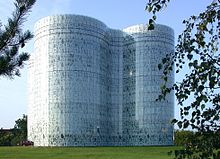
The IKMZ in Cottbus was opened in 2004.

The districts of Potsdam, Frankfurt (Oder) and Cottbus in the GDR
.svg.png)
The Province of Brandenburg in the German Empire (1871-1918)

The situation around 1150 east of the Elbe, the Ascanian ancestral lands lay west of the river
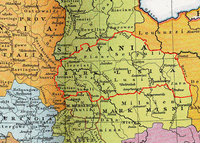
The Mark Lusatia around 1000

The Nordmark (pink) between 972 and 1032

The Mark Brandenburg in the year 1320
Questions and Answers
Q: What is Brandenburg?
A: Brandenburg is a state (Bundesland) in Germany.
Q: When did it become a state?
A: Brandenburg has been a state since 1990.
Q: How big is it?
A: Brandenburg is 29,480 km² in area.
Q: How many people live there?
A: There are about 2.6 million inhabitants in Brandenburg.
Q: What was its size and population before 1945?
A: Before 1945, Brandenburg was the biggest province in Prussia with 38,278 km² and 3 million inhabitants.
Q: Was it part of the German Democratic Republic from 1949 to 1952?
A: Yes, from 1949 to 1952 Brandenburg was a state in the German Democratic Republic.
Q: What is the capital of Brandenburg?
A: The capital of Brandenburg is Potsdam.
Search within the encyclopedia